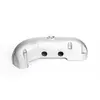Mobile:+86-311-808-126-83
Email:info@ydcastings.com
die casting tool
Die Casting Tools An In-Depth Exploration
Die casting is a manufacturing process that involves forcing molten metal into a mold cavity. This method is widely used to produce parts with intricate shapes and high dimensional accuracy, making it a preferred choice across various industries, including automotive, aerospace, electronics, and consumer goods. Central to the efficiency and effectiveness of die casting is the die casting tool, which encompasses the molds and machinery required for the process. This article delves into the components, types, and significance of die casting tools, highlighting their role in modern manufacturing.
Components of Die Casting Tools
Die casting tools consist of several key components that work in unison to facilitate the casting process. The primary elements include the die, the die assembly, the injection system, and the cooling system.
1. The Die The die itself is made of two halves the cover die and the ejector die. The cover die, often stationary, holds the molten metal, while the ejector die, which can move, ejects the finished part after cooling. These dies are constructed from high-grade steel or other durable materials to withstand the intense pressure and temperatures involved in the casting process.
2. Die Assembly The die assembly refers to the complete assembly of the die, including the guiding pins, springs, and other mechanisms that ensure precise alignment and operation during the casting cycle. Proper assembly is crucial for maintaining the quality of the cast parts.
3. Injection System The injection system plays a vital role in controlling the flow of molten metal into the cavity. This system may utilize either hot chamber or cold chamber designs. In a hot chamber system, the furnace is directly connected to the injection mechanism, suitable for low-melting-point alloys. Conversely, a cold chamber system requires the metal to be poured into the injection cylinder before being injected, which is commonly used for higher melting-point metals.
4. Cooling System Effective cooling is essential for achieving the desired hardness and surface finish of the cast part. The cooling system circulates coolant, typically water, through channels in the die to remove heat from the molten metal quickly, allowing for faster cycle times while maintaining part quality.
Types of Die Casting Tools
Die casting tools can be classified based on several criteria, such as the type of metal used, the method of injection, and the complexity of the part being produced. Broadly, the two main types of die casting are
die casting tool

1. High-Pressure Die Casting This method involves injecting molten metal into the die at high pressure, which features high dimensional accuracy and smooth surface finishes. It is ideal for large-scale production of parts with complex geometries.
2. Low-Pressure Die Casting A less common method where molten metal is drawn into the die by low pressure. This technique is often used for large, thicker parts and is generally slower and more suited for smaller productions.
Importance of Die Casting Tools in Manufacturing
The significance of die casting tools in the manufacturing domain cannot be overstated. They play a crucial role in several aspects
1. Cost Efficiency While the initial investment in die casting tools may be high, the efficiency of the process leads to lower costs per unit when producing large quantities. The rapid cycle times and minimal waste make it a cost-effective choice for mass production.
2. Precision and Quality Die casting tools enable the production of parts that require high precision and consistent quality. The tight tolerances achievable through this method reduce the need for extensive post-processing, ensuring that components meet rigorous industry standards.
3. Versatility Die casting is not limited to a single metal type; various alloys such as aluminum, zinc, and magnesium can be used, offering flexibility to manufacturers in choosing materials that suit their specific needs. This versatility makes die casting tools essential for companies involved in diverse applications.
4. Sustainability Modern die casting equipment and practices are increasingly focused on sustainability. The process generates minimal waste, and many metals used in die casting are recyclable, contributing to environmentally friendly manufacturing practices.
Conclusion
In conclusion, die casting tools are indispensable to contemporary manufacturing, significantly impacting efficiency, precision, and cost-effectiveness. As technology continues to advance, the evolution of die casting tools will further enhance their capabilities, ensuring that this manufacturing method remains at the forefront of industrial innovation. Whether producing intricate automotive components or essential electronic parts, the role of die casting tools is vital in shaping the future of manufacturing.
-
Why Should You Invest in Superior Pump Castings for Your Equipment?NewsJun.09,2025
-
Unlock Performance Potential with Stainless Impellers and Aluminum End CapsNewsJun.09,2025
-
Revolutionize Your Machinery with Superior Cast Iron and Aluminum ComponentsNewsJun.09,2025
-
Revolutionize Fluid Dynamics with Premium Pump ComponentsNewsJun.09,2025
-
Optimizing Industrial Systems with Essential Valve ComponentsNewsJun.09,2025
-
Elevate Grid Efficiency with High-Precision Power CastingsNewsJun.09,2025











